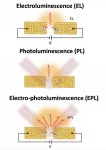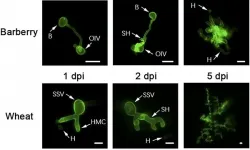The rapid transition to remote study came with its own learning curve for students and faculty alike. But for many students with disabilities, the shift offered new educational modalities as well as challenges - and the hope that some changes will continue after the threat of the virus subsides.
"This was a really unique, historical moment," says Nicholas Gelbar '06 (ED), '07 MEd, '13 Ph.D., an associate research professor with the Neag School of Education. "Remote learning, online learning, had been percolating for a while, and then there's this moment where everything went online. For the group that we research - college students with disabilities - this is an especially unique time, because most of the services they receive at the college level are set up for in-person learning. This shift made us wonder, how do these services and these supports, these accommodations that they receive, how do they translate to this online world?"
Gelbar is a co-author of a new study, recently published in the Journal of Postsecondary Education and Disability, that examined the impact of the rapid transition to online learning during the spring 2020 academic semester on college students with disabilities. The researchers conducted a national survey of more than 340 students in both two and four-year programs to measure the perceptions of college students with disabilities about their experiences. The online survey was conducted in August and September 2020.
Overall, the researchers found that, despite certain drawbacks, the students surveyed felt supported by their institutions, faculty, and disability services offices.
"What we found is that the students said there were things that were kind of advantageous and there were things that were harder in the online environment," Gelbar says. "They found the learning management systems accessible. They were able to change how they took notes, because they were able to watch an online lecture and then watch it over again, so they could take notes multiple ways. They said their instructors were really helpful about communicating any changes to assignments or projects that happened."
Gelbar continued, "The drawback was that they reported having family demands that impacted their learning. They talked about how home isn't always the best place to do their studying - there's distractions. They said they felt less connected to other students and to their instructors."
A major, positive change reported by the students was the shift to online communication with disability service providers at their universities, who typically help students access the accommodations they need to conduct their studies, things like extended deadlines on assignments, more time for test taking, and assistance with taking notes.
"There were lots of universities that responded by saying, 'well, you aren't on campus anymore, so how do we get you changes to your accommodations?'" says study co-author Michael Faggella-Luby, a professor of special education at Texas Christian University, director of the Alice Neeley Special Education Research and Service (ANSERS) Institute, and a former associate professor at the Neag School of Education. "We can't do it the old way, where, you come in and meet with us, we write you a letter, you take the letter to your professor, they sign it. We can't do this anymore, so some universities responded by moving the whole process online. Well, now everybody wins. It's much easier to do those things."
It's also more private, Faggella-Luby says - allowing students to discuss their need for accommodations with their professors outside of an open classroom environment.
"We know only half the college kids who have disabilities when they get to college file the paperwork to get the services that they have an entitlement to," says Faggella-Luby. "Why? Well, at least for some, they don't want to be one of those kids who has to stay behind at the end of the first class with a piece of paper in their hand, basically saying, 'Hi, I'm a kid with a disability.' What this did was expedite, but also destigmatize - create an opportunity for folks to be able to communicate in a private way about something that is very private, and yet still maintain a high level of services. That to me was essential."
"Some students with chronic health issues talked about how even going to meet with the disability service staff was a challenge because of the health issues - just getting across campus - but being able to check in virtually made all the difference," says Joseph Madaus, professor of educational psychology with the Neag School of Education; director of UConn's Collaborative on Postsecondary Education and Disability, or CPED; and principal investigator for the study.
Communication, the researchers said, was at the heart of the responses they received, which they said were highly bimodal - respondents had either very positive or very negative feelings about how things went at their university.
"When the students talked about what worked well and what was important, it was clear, consistent, early, proactive communication and flexibility," says Madaus. "And then when students talked about what didn't go well, it was that the communication wasn't clear and it wasn't proactive and things were just not stable anymore."
"We were concerned that maybe kids lost access to their accommodations, and then just got railroaded and totally forgotten about," Faggella-Luby says. "In fact, that wasn't what they were telling us. Instead, there were these positive ways of communicating. People were seeing if they needed additional accommodations. The professors going online and making the video pause-able, which they've never done before, now allowed them to have completely different, enhanced access, without having to ask for it."
The students also noted the benefits of changes - like the availability of closed captioning and transcripts for recorded lectures, and flexibility on assignments and due dates - which Madaus noted are also principles of Universal Design for Learning, a framework for teaching faculty to incorporate methods that support multiple ways of learning while maintaining quality educational standards.
"The students didn't voice this, but what they said fell into categories of Universal Design, where faculty are presenting material in multiple ways," Madaus said, "and that benefits not only the students with disabilities, but it will benefit a wide range of learners within the environment."
The researchers noted their sample included mostly women, that most participants were from the eastern portion of the country, and that the study represented only a snapshot in time - focusing on period when the pandemic was new.
"We've wondered if maybe the students had a higher tolerance, because they sort of appreciated that this shift that happened was unprecedented and that everyone was basically doing the best that they could," Gelbar says.
The research team is currently crafting a second survey to look at how students with disabilities perceived their educational experiences into 2020-2021 academic year, when the pandemic had been ongoing for months and faculty would have presumably had more time to prepare for a completely remote experience. They also intend to ask additional questions about the impact of quarantine on learning as well as the pandemic's overall impact on student mental health.
But what the study did show, the researchers said, is that, for disability service providers, offering some form of remote services is beneficial, as is proactively providing course offerings in different modalities that can make course materials more accessible to all students.
"In the online format, we can make things more accessible to students," Gelbar says, "and the more that we do that proactively, it's not only benefiting students with disabilities, but all students."
"The benefits of high-quality training for university faculty and these Universal Design practices help every single discipline," says Faggella-Luby, "and what comes out of it is better content-area learning, And it's not one more thing to do, it's the right thing to do, and kids learn better. Your degree means more, their mastery is better. It's a horrible situation that we had to go through, but I hope that's something that lives from this."
INFORMATION:
This study was also co-authored by Lyman Dukes III '01 PhD, a professor of special education in the College of Education at the University of South Florida.





